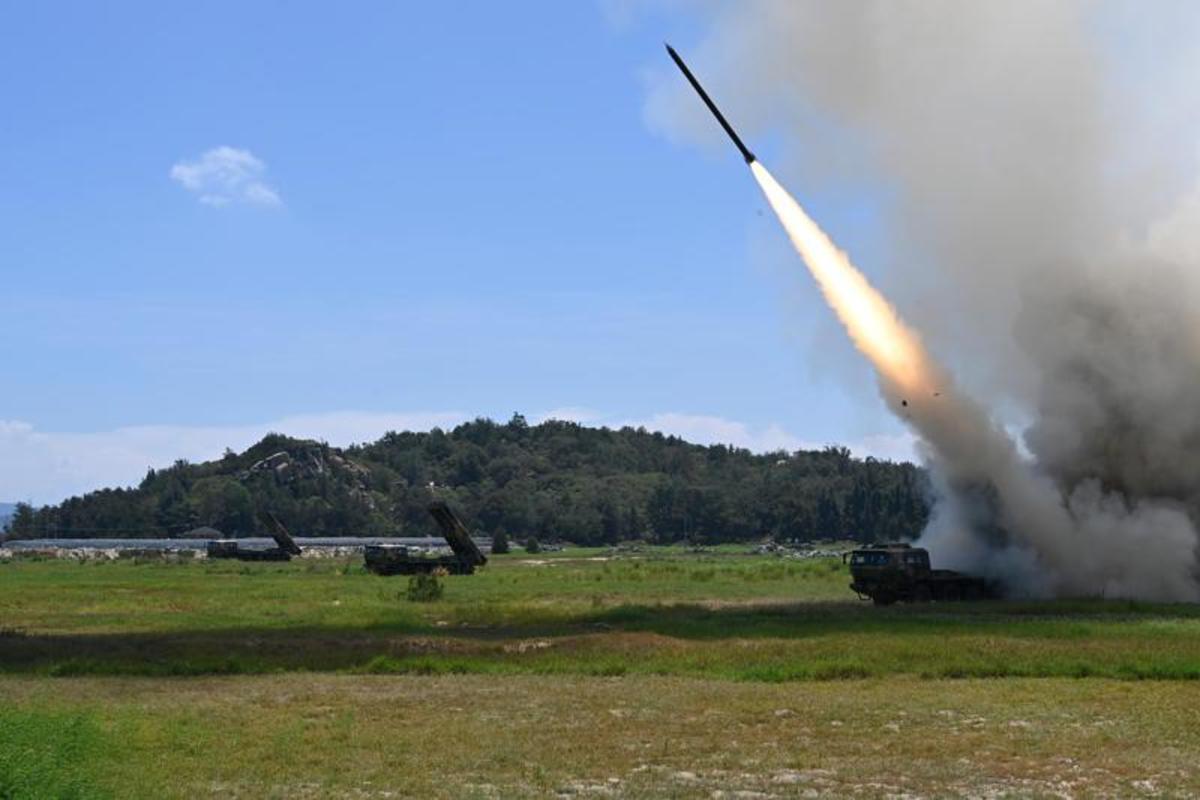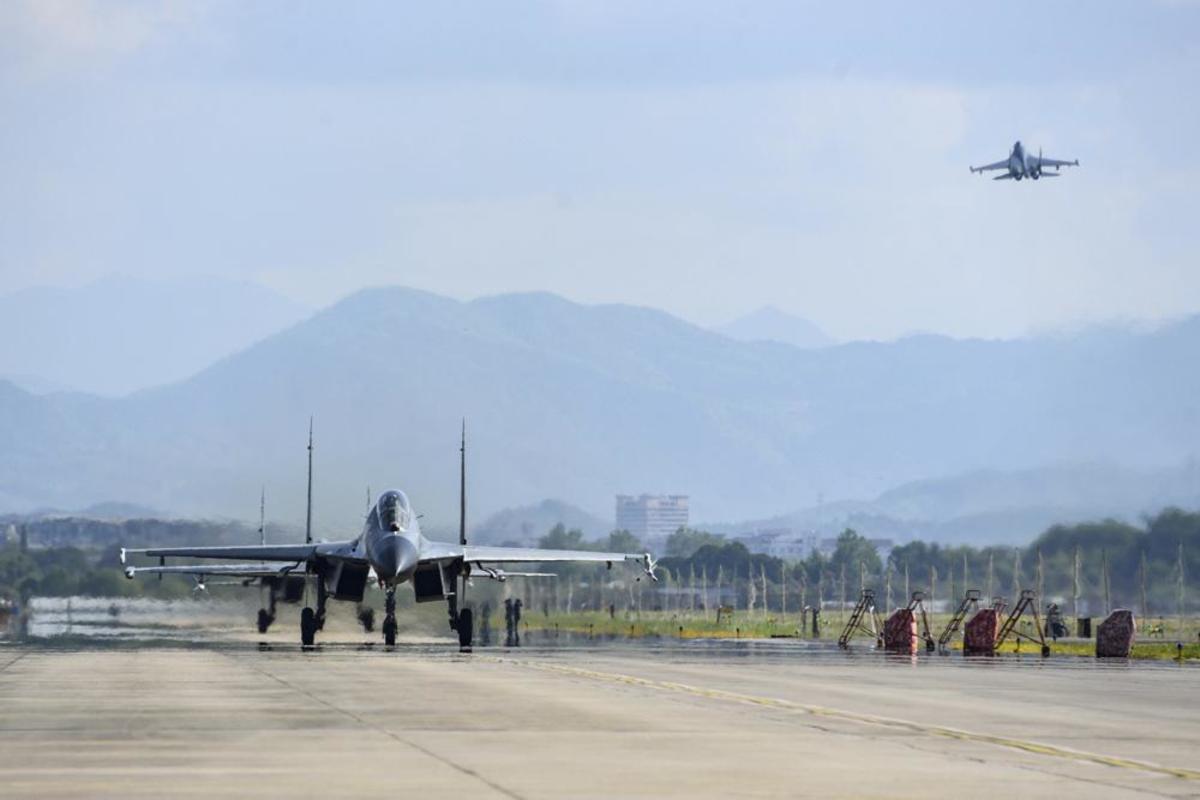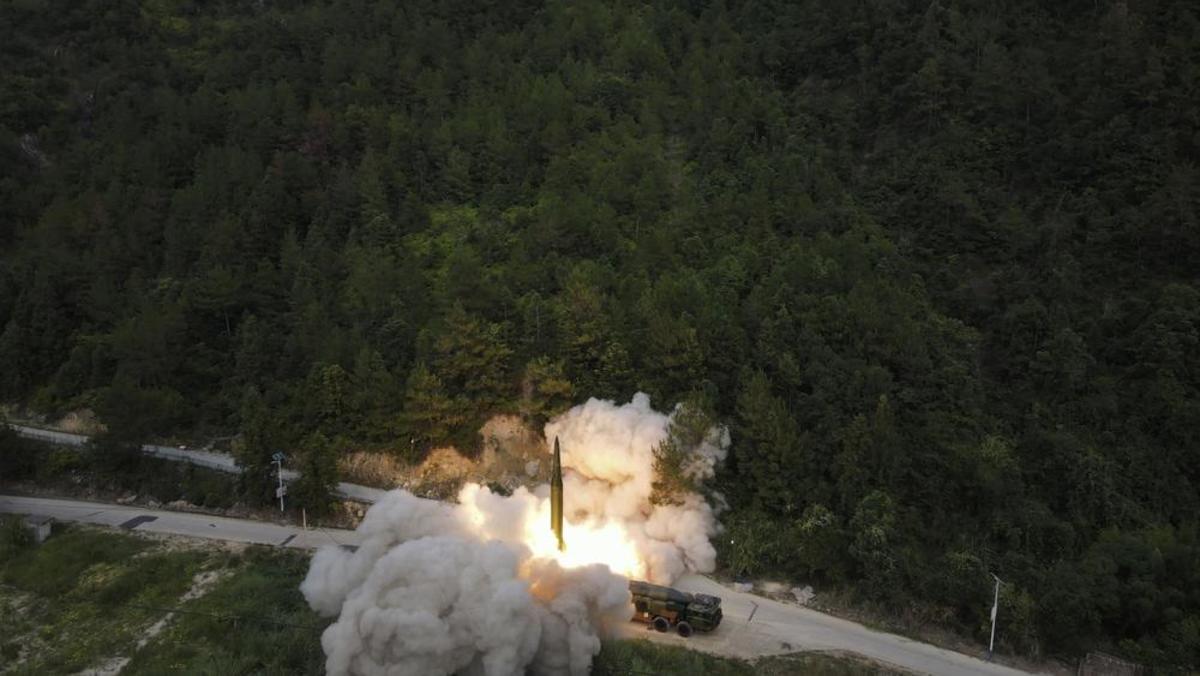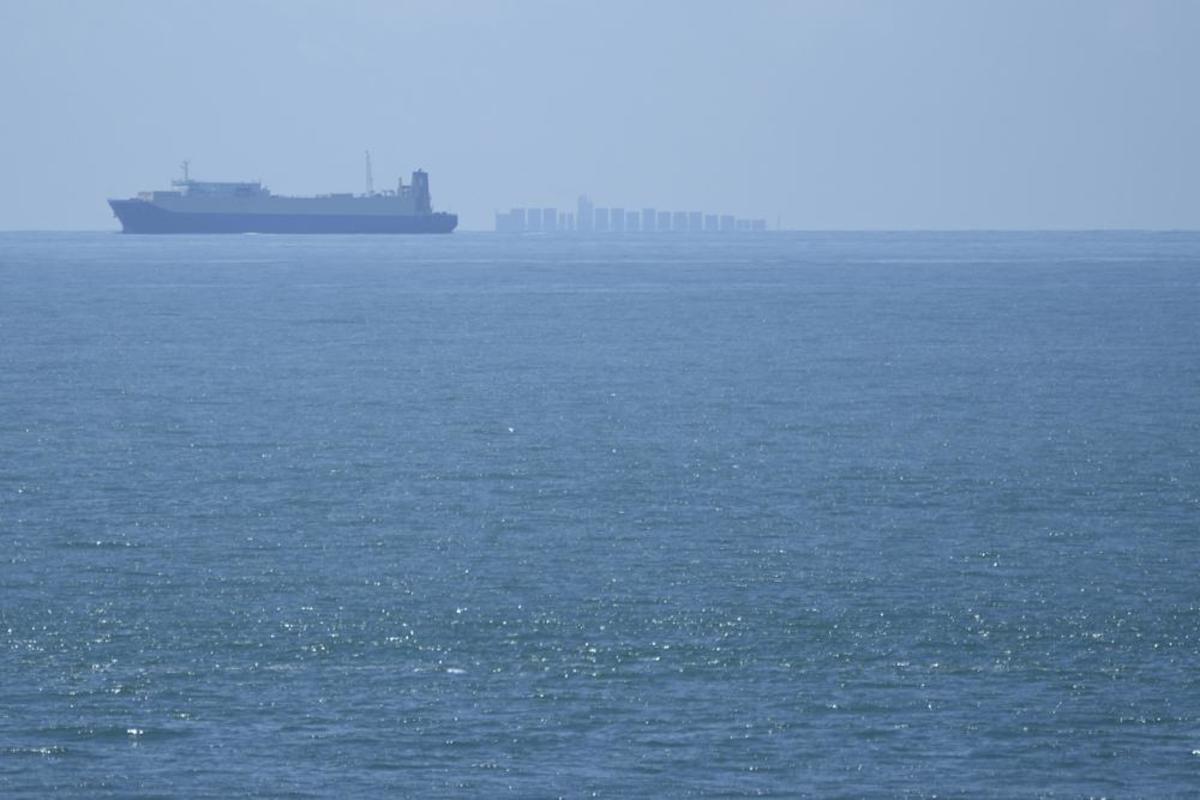KRIS OSBORN
With tensions potentially higher than they have been in years, and Chinese weapons, planes and warships conducting war drills encircling Taiwan, the possibility of a massive Chinese-US confrontation may now look more realistic, if not imminent.
Several Pentagon reports and think tank studies have in recent months raised the question of whether Taiwan could quickly be taken over by China, creating a “fait-accompli” circumstance wherein any effort to remove occupying Chinese forces by force could introduce potentially unprecedented and catastrophic consequences.
Much of this simply seems to pertain to a simple, self-evident question … could U.S., Japanese, South Korean and Australian forces get there fast enough? Could there be an effective, coordinated multi-domain response within the crucial, and likely quite small time window afforded during a Chinese attack? How quickly would a Chinese attack be detected? How far away are response forces?

In this photo released by China's Xinhua News Agency, a projectile is launched from an unspecified location in China during long-range live-fire drills by the army of the Eastern Theater Command of the Chinese People's Liberation Army, Thursday, Aug. 4, 2022. China conducted "precision missile strikes" Thursday in waters off Taiwan's coasts as part of military exercises that have raised tensions in the region to their highest level in decades following a visit by U.S. House Speaker Nancy Pelosi. (Lai Qiaoquan/Xinhua via AP)
Could Chinese air power and carriers in the Taiwan strait in striking distance of Japan successfully defend a possible Taiwan occupation from US and Japanese defensive counterattacks? Certainly a question including a number of variables. Chinese carriers and amphibs could successful in any amphibious assault to take over Taiwan, if US and Japanese forces could not get there in time or simply were not close enough to intervene in an impactful way. This is particularly true when it comes to air power, meaning should the US and its allies have sufficient numbers of F-35s in position to respond, a Chinese amphibious attack would likely have a lot of trouble succeeding.
However, should Japanese, South Korean or US forces have sufficient indications of an imminent invasion or obtain crucial intelligence information, US Navy and Japanese assets could be in close enough proximity to challenge or stop a Chinese takeover of Taiwan.
This is likely a key reason why US Pacific Command operates a large number of ships and assets in the region and regularly conducts forward operations such as training, combat preparation drills or carrier aircraft launch operations. Forward presence could be the deciding factor in any kind of scenario involving attack.
First, attacking Chinese forces would likely have a very difficult time establishing air superiority in support of an amphibious assault should US carrier-launched F-35Cs and amphib-launched F-35Bs be within range of attack.

In this photo released by China's Xinhua News Agency, air force and naval aviation corps of the Eastern Theater Command of the Chinese People's Liberation Army (PLA) fly planes at an unspecified location in China, Thursday, Aug. 4, 2022. China conducted "precision missile strikes" Thursday in waters off Taiwan's coasts as part of military exercises that have raised tensions in the region to their highest level in decades following a visit by U.S. House Speaker Nancy Pelosi. (Fu Gan/Xinhua via AP)
Chinese J-15s or even some of its small number of J-20s would likely have trouble. Without clear air supremacy, an amphibious force would be extremely vulnerable to attack from US or Japanese 5th-generation aircraft such as F-35s.
Another key variable likely to make a Chinese move on Taiwan very difficult is the potential presence of US submarines. Virginia-class attack submarines are increasingly engineered with advanced sonar and quieting technologies such that they can approach high risk areas less likely to be available to more easily detected surface ships.
Hidden submarines can therefore perform clandestine reconnaissance missions in high-risk coastal areas. Should they remain undetected, US Navy attack submarines could succeed in attacking, disrupting or even destroying attacking Chinese ships traveling to Taiwan.
The challenge of defending Taiwan may be why senior Pentagon leaders from Secretary Lloyd Austin to Air Force Chief of Staff Gen. Charles Brown, Army Chief of Staff Gen. James McConvile and DoD’s recently published “China Report” all specifically cite China as a serious and “pacing” threat to the United States and its allies.
Much of this is widely discussed and quite well known, as many lawmakers, senior Pentagon leaders and weapons developers consistently reference China’s hypersonic weapons progress, large, technologically sophisticated and growing Navy, 5th-generation aircraft, nuclear arsenal and two-million strong ground force.
The thinking may simply be that an extremely strong, full-scale deterrence posture might not only be necessary but the best, if not only true option when it comes to stopping China.
A cursory look at the geography, surrounding force posture and available war assets in position to respond to Chinese invasion, seems to suggest that some kind of rapid, “fait accompli” type of immediate takeover might appear realistic.
This prospect, however, presumes that U.S. and allied Air Forces, long-range weapons and ship-launched assets were not able to thwart, slow-down or stop a Chinese air-sea attack quickly enough, before they would land on Taiwanese shores. Should that happen, the U.S. and its allies would of course face a much different scenario.

In this photo released by China's Xinhua News Agency, a projectile is launched at an unspecified location in China during long-range live-fire drills by the rocket force of the Eastern Theater Command of the Chinese People's Liberation Army targeting maritime areas east of Taiwan, Thursday, Aug. 4, 2022. China conducted "precision missile strikes" Thursday in waters off Taiwan's coasts as part of military exercises that have raised tensions in the region to their highest level in decades following a visit by U.S. House Speaker Nancy Pelosi. (Wang Yi/Xinhua via AP)
The best hopes, therefore, likely reside in an effective deterrence posture and a U.S. and allied ability to leverage air superiority, forward, power-projecting forces such as carries and highly effective, networked air and missile defenses in position to blunt an opening salvo of Chinese ballistic missiles fired at Taiwan.
The hope, it may seem clear, is that U.S. intelligence and allied surveillance in the form of undersea and aerial drones, submarines and even satellites might discover preparations for an invasion early enough to position a response.
Should allied air superiority be established quickly, and the Chinese Air Force is, in terms of sheer numbers or “mass” much less dangerous to the U.S. and its allies than its Naval and Ground forces, then there may indeed be hope that a major invasion could be stopped before reaching the shores.
Given that Taiwan is merely 100 miles off the Chinese coast, this may be a tall order. It may simply be a question of time.
Should the answer be yes, they would of course need air and maritime superiority. An amphibious assault carrying large numbers of Chinese troops and heavy armor would, it seems clear, most likely need to be destroyed from the air to prevent a “fait accompli.”
What if China Actually Occupied Taiwan?
Should large portions of China’s 2-million strong land Army and 35,000 armored vehicles succeed in landing on and “occupying” Taiwan, what options might there be for the U.S. and its Pacific allies?
The principle impediment to a successful rapid counterattack may simply be a sheer question of geography. South Korea operates roughly 2.6 thousand tanks, Japan maintains a fleet of roughly 1,000 tanks and Taiwan itself is listed by Global Firepower as having 1,160 tanks.
However, should China land large numbers of its three-thousand-strong tank force and 1,970 self-propelled Howitzers, could any kind of countervailing ground response force get there in time? A quick look might suggest no.

Ships move through the Taiwan Strait as seen from the 68-nautical-mile scenic spot, the closest point in mainland China to the island of Taiwan, in Pingtan in southeastern China's Fujian Province, Friday, Aug. 5, 2022. China conducted "precision missile strikes" Thursday in waters off Taiwan's coasts as part of military exercises that have raised tensions in the region to their highest level in decades following a visit by U.S. House Speaker Nancy Pelosi. (AP Photo/Ng Han Guan)
Southern Japan and South Korea are, depending upon where ships depart, somewhere between 500 and 1,000-miles away. While this would possibly put Taiwan in range of tanker-refueled or sea-launched fighter jets and some long-range missiles, a heavily armored force is extremely difficult to deploy and would need to be pre-positioned.
This simple, yet clear circumstance may explain why there have been so many reports about Taiwan’s acquisition of Abrams tanks.
Could there be enough mechanized, armored resistance sufficient enough to slow-down a Chinese incursion long enough to enable allied forces such as Japan, South Korea and forward-placed U.S. forces to respond? Does not appear too likely, unless the U.S. and its allies took a measured and potentially highly controversial step to “pre-position” a large-scale armored force prior to any invasion. As contentious as that would be, could it work as a deterrent?
Training and readiness may also be a huge factor for Taiwan, as Global Firepower states the island nation has as many as 1.6 million reserves. Korea is listed as operating an extremely large reserve force of 3.1 million reserve forces. While likely prepared for a North Korean contingency across the DMZ, these forces could certainly have an impact should Taiwan need to be liberated. How trained, equipped and ready would these forces be?
Do they have weapons, equipment and training? Most of all, how fast can they get there? Australian land forces would not only be extremely far away but also quite small in numbers, as Global Firepower cites the country as operating only 60,000 active duty soldiers
How do U.S. numbers stack up? The United States INDO-PACIFC Command website says U.S. Army Pacific has approximately 106,000 personnel in theater, from one Corps and two divisions. The U.S. does operate a large number of bases in Japan and of course has troops in South Korea, but would that be even close to enough if facing a Chinese land-army cited as operating 2.1 -million soldiers?
U.S. Army Pacific also has over 300 aircraft and five watercraft assigned throughout the AOR from Japan and Korea to Alaska and Hawaii, the command said in a statement.
Extracting an entrenched Chinese Army from Taiwan would not be a small task. A look at a combined U.S., Japanese and South Korean land forces seem to suggest that, at very least, defeating China on the ground in Taiwan is “realistic,” if not even likely. A combined U.S., Taiwanese, Japanese and South Korean land force, however, should it operate with air superiority, might be well-positioned to ultimately prevail. The question for many, it seems clear, would be ..”at what cost.”
Victory, and air superiority, would almost certainly rely upon the U.S. Pacific Fleet from the ocean, as INDOPACOM says the command operates 200 ships to include five aircraft carrier strike groups and as many as 1,100 aircraft. These maritime operated aircraft could ultimately be a deciding factor in stopping a Chinese amphibious assault and establishing air superiority to support a ground counterattack.
No comments:
Post a Comment